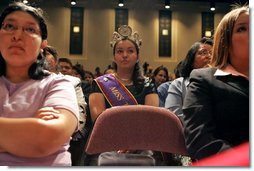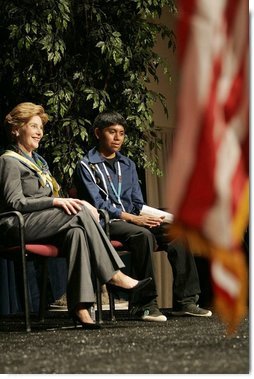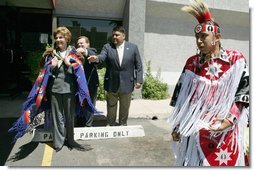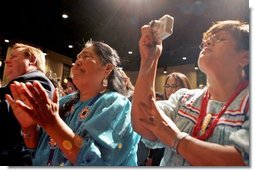|
Home >
News & Policies >
April 2005
|
For Immediate Release
Office of the First Lady
April 26, 2005
Mrs. Bush's Remarks at Helping America's Youth Event in Arizona
The Heard Museum
Phoenix, Arizona
12:45 P.M. MST
MRS. BUSH: Thank you. Thanks, everybody. Derwin, thank you very much for your very excellent introduction and for telling us about your story. I'm impressed by your determination to avoid risky behaviors and to stay connected to your family and your culture, and to the good values that you've learned from them.
 I want to acknowledge John Lewis, Executive Director, Inner-Tribal
Council of Arizona. Thank you very, very much for joining us today and
introducing me, as well. And also to Frank Goodyear, the Director of
the Heard Museum. As all of you know, the Heard Museum depicts the
vibrant life of the Native Americans.
I want to acknowledge John Lewis, Executive Director, Inner-Tribal
Council of Arizona. Thank you very, very much for joining us today and
introducing me, as well. And also to Frank Goodyear, the Director of
the Heard Museum. As all of you know, the Heard Museum depicts the
vibrant life of the Native Americans.
Also, to all the tribal leaders and elders who serve as role models and as guides for our youth, to the tribal youth royalty who are here, who represent the tribal nations at events around the country, and who serve as role models for other young people in your communities. Thank you all so much for what you do and thank you for joining me today.
In his State of the Union address this year, President Bush announced a new initiative called Helping America's Youth. The goal of Helping America's Youth is to help children make healthy decisions in their lives so they can grow up to be successful and healthy. The initiative calls for actions in the three most important parts of a child's life: a child's family, a child's school, and a child's community. We all know that boys and girls, especially as they get to their teen years, face hazards. Smoking and drinking may look appealing to children when they see older kids doing it. Drugs are a temptation. Young people often feel pressured to have sex. Gangs and violence are a regular presence in many neighborhoods.
These challenges aren't limited to any one part of the country or to any one segment of society. Every child has to make the choice between healthy behaviors that lead to success and risky behaviors that can lead down a road of bad outcomes. Our responsibility as adults is to help children resist negative pressures and excel in every part of their lives.
Tribal youth face the same challenges that other kids in America face. Native American parents worry about their children using drugs or alcohol. They worry about sexual activity that can lead to early pregnancy or sexually transmitted diseases. They worry about violence, a fear that was heightened by the recent tragedy at Red Lake High School in Minnesota.
A particular concern is that tribal youth who live in big cities like Phoenix can become disconnected from their culture. As teens struggle to figure out who they are and where they fit in the world, a connection to their family and their heritage lends stability to their lives. The strong inter-generational ties of Native American culture are a great benefit for children. Young people who hear positive messages from their parents, their grandparents, their aunts and uncles, are more likely to avoid risky behaviors, and this is true in every culture.
 The bonds of family and culture that exist on reservations may not
be as strong in urban environments. It can be hard for a family to
maintain a strong cultural identity when they live among so many
competing influences. That's why many efforts to help tribal youth
include cultural traditions.
The bonds of family and culture that exist on reservations may not
be as strong in urban environments. It can be hard for a family to
maintain a strong cultural identity when they live among so many
competing influences. That's why many efforts to help tribal youth
include cultural traditions.
Earlier today, I visited the Native American Community Health Center, which hosts the Red Road Youth Empowerment Project. As Derwin said, the Red Road represents the good path in life. The program is designed to help urban tribal youth make decisions to keep them on track to be healthy and successful adults. American Indian cultural practices and spiritual traditions are at the heart of the program. One of those practices is the use of the drums, which boys and girls demonstrated for me. The drum has called people together! for centuries, and by introducing tribal youth who live in cities to a tradition that has been practiced by their ancestors, Red Road gives young people a sense of belonging and identity. It gives them a reason to be proud of their heritage. And it gives them the encouragement to continue with their own lives, their rich traditional and cultural traditions.
Every child should have goals and aspirations. When a child has a goal, it means he has hope. He has something he wants to accomplish. The Hoop of Learning Internship Program helps tribal youth reach the goal of becoming medical professionals. A great education is the key to becoming a health care worker, a doctor or a nurse. The Hoop of Learning motivates students to do well in school, to graduate from high school and to go on to college.
The Phoenix Union School District and the Gate Way Community College are incorporating Hoop of Learning programs, and they've seen encouraging results. Students are taking college-level courses in high school, and they're participating in internships that give them a head start on their career. Tribal youth are introduced to one of the most respected professions in our nation, and they're given the opportunity to spend a lifetime of service to others.
The Salt River Pima-Maricopa Indian Community is finding solutions to the problems that young people face on their reservation. Law enforcement, health care, education and housing authorities are working together to help children at every stage of their development. They have plans to reduce substance abuse, to provide group housing for young adults transitioning out of foster care and back onto the reservation, to educate the community about family and school violence and to provide counseling and recreational services for youth.
 This morning, I met Amber who was helped by the Juvenile Drug Court
program, run by the Salt River Pima-Maricopa Indian Community. Amber
was using drugs and acting out at home and at school. She had poor
self-esteem and little hope for a better future. But in the Drug Court
program, Amber received a dose of authority and love. She had to
submit to regular drug testing, and she had access to counseling to
help her overcome her behavioral and emotional problems. Amber's
parents stayed involved in her treatment, letting her know that she had
their love and support.
This morning, I met Amber who was helped by the Juvenile Drug Court
program, run by the Salt River Pima-Maricopa Indian Community. Amber
was using drugs and acting out at home and at school. She had poor
self-esteem and little hope for a better future. But in the Drug Court
program, Amber received a dose of authority and love. She had to
submit to regular drug testing, and she had access to counseling to
help her overcome her behavioral and emotional problems. Amber's
parents stayed involved in her treatment, letting her know that she had
their love and support.
Today, Amber is free from drugs. She's working toward her GED so she can improve her chances of providing a good life for herself and her children. She also stays involved in the Drug Court program, sharing her story and providing inspiration to other young people struggling to overcome their addictions.
Through Helping America's Youth, we're encouraging communities to follow the example that is set here by recognizing their needs and then acting together to meet those needs. The President has introduced several initiatives that support local communities, including funding to provide mentors for children who have a parent in prison, and a new proposal to reduce gang violence and gang involvement. The Responsible Fatherhood Initiative and the Healthy Marriage Initiative are designed to keep families strong and stable, so that whenever possible, children can grow up with two loving parents in their home.
One of the most important ways the federal government can help local communities is by fostering connections between people who are running good programs and people who want to get started. This fall, we'll convene a White House Conference on Helping America's Youth to discuss some of the best practices to help children avoid risky behaviors and become responsible, healthy adults. The conference will introduce a new assessment tool so that communities can identify the challenges they face and the services that already exist to meet them, and then community leaders can integrate federal and local programs to create a seamless effort to help the youth and children in their communities.
Helping America's Youth depends on partnerships within communities, and on the individual commitment of every American. The time between childhood and adulthood is all too short, as George and I can attest, and every moment in a child's life is precious. After I visited a program in Detroit, a newspaper reporter asked one of the little boys that I met what he thought of my visit, and I was moved when I read that he simply said, "I wish she could stay here."
 Children want us in their lives, and children need us in their
lives. And as I've learned today from the remarkable men and women
I've met, each of us has the power to make the difference in the life
of a child.
Children want us in their lives, and children need us in their
lives. And as I've learned today from the remarkable men and women
I've met, each of us has the power to make the difference in the life
of a child.
Thank you all very much. Thank you for what you're already doing to help the children in your communities. Thank you very much.
END 12:56 P.M. MST
![]() Printer-Friendly Version
Printer-Friendly Version
![]() Email This Page
Email This Page


